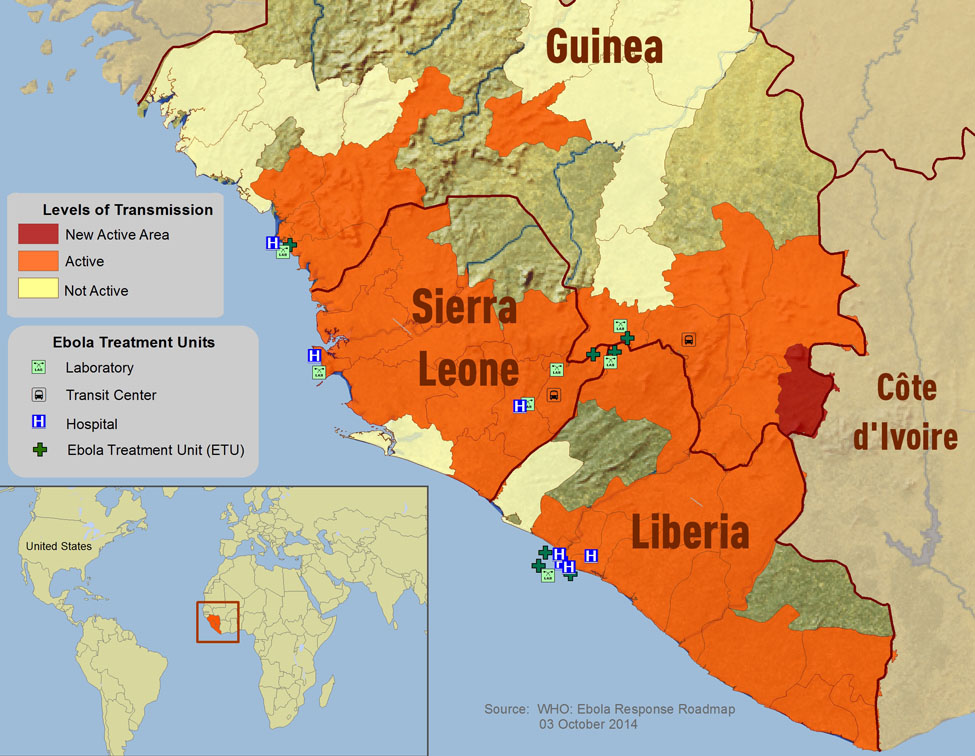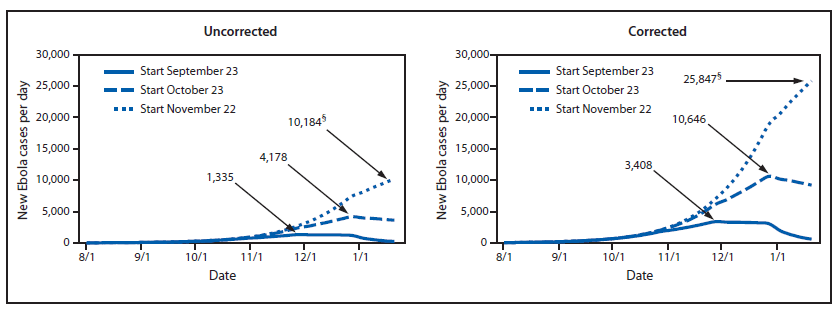I am a scientist with a background in Microbiology and Virology and what is happening (or more importantly what is not happening) with the current Ebola outbreak is very worrying. Rather than just scare my family I thought I should do a write up about what needs to be done.

Figure 1. Scale of the Ebola outbreak October 2014 (source WHO).
Where are we right now?
Ebola is completely out of control and the case numbers are doubling every 20 days or so. It does not look like Ebola had changed (it certainly could), it has just overwhelmed the containment systems we had in place in west Africa. The hospitals in the affected areas have reached (exceed) capacity and are not able to take in any new patients so the virus is running wild (this point seems to have been reached around August). A consequence of this is we really have a very poor idea of the number of cases since no-one is recording the cases that don’t make it to hospital.
What is going to happen?
Ebola is actually a very well studied virus from an epidemiological perspective so we can model its spread quite accurately. Here is what is going to happen according to the CDC.
Figure 2. Estimated impact of delaying intervention* on daily number of Ebola cases, with and without correction for underreporting† — EbolaResponse modeling tool, Liberia, 2014–2015 (source CDC).
* Intervention: Starting on September 23, 2014 (day 181 in model), and for the next 30 days, the percentage of all patients in Ebola treatment units was increased from 10% to 13%. This percentage was again increased on October 23, 2014 (day 211 in model) to 25%, on November 22, 2014 (day 241 in model) to 40%, and finally on December 22, 2014 (day 271 in model) to 70%. Day 1 in model is March 3, 2014. The impact of a delay of starting the increase in interventions was then estimated by twice repeating the above scenario but setting the start day on either October 23, 2014, or November 22, 2014.
† Corrected for potential underreporting by multiplying reported cases by a factor of 2.5 (Table 4).
§ New Ebola patients at peak of each start date. (Note that when the intervention is started on November 22, 2014, the peak is not reached by January 20, 2014, which is the last date included in the model.)
The only thing missing from this modelling is the “do nothing” option since the CDC has assumed that we will start doing something by November 22nd (unlikely). They have also been too scared to model past January 2015.
This modelling also assumes that the virus does not become better adapted to spread in humans which could, and may even be likely, to happen. The most probable adaption would not be for Ebola to become airborne (this is only slightly less likely than pigs becoming airborne), but for the virus to slow down in the speed in which it kills people so they stay infectious for a longer period of time. A strain could arise that takes a month to kill you (rather than a week) and where you are asymptomatic, but infectious, for a couple of weeks. Such a strain would allow each patient to infect many more people before they died or recovered. One of the reasons that Ebola has not caused major outbreaks in the past is that it kills so rapidly that there is little time for each patient to infect new people. The selection pressure on Ebola to slow the speed in which it kills is extremely strong and the more people infected the more likely it becomes that such a mutation will occur.
Why did this Ebola outbreak get so bad?
This is a good question as it is not the first Ebola outbreak. The best explanation I have seen is from the discoverer of Ebola, Professor Piot, as quoted in De Spiegel.
SPIEGEL: Why did WHO react so late?
Piot: On the one hand, it was because their African regional office isn’t staffed with the most capable people but with political appointees. And the headquarters in Geneva suffered large budget cuts that had been agreed to by member states. The department for hemorrhagic fever and the one responsible for the management of epidemic emergencies were hit hard. But since August, WHO has regained a leadership role.
What do we need to do to stop Ebola?
We need to get the R0 below 1. This means each infected person needs to infects less than one new person. Right now the R0 is somewhere between 2 and 10 (i.e. each infected person is infecting between 2 to 10 new people). To get the R0 of Ebola below 1 we need to move at least 70% of infected people into properly functioning infection control hospitals. Sounds easy doesn’t it?
How do we actually do this?
This outbreak is now beyond the ability of the governments in the affected areas, the WHO, or any NGO to bring under control (the head of MSF has stated that the outbreak is now beyond their ability to deal with). There is only one option left which is full-scale military mobilisation. In practicable terms this is what needs to happen:
- The UN Security Council needs to authorise the use of all available resources to control and contain the outbreak in the affected countries and surrounding regions including the use of international military force. This needs to be done as soon as possible (days not weeks).
- Those countries with the ability to do this (the USA mostly) need to move to full-scale military mobilisation (i.e. war level)*. This may require conscription of the required healthcare workers, but if we are lucky and act soon we might be able to get by with just volunteers.
- Start an outside-in Ebola containment/infection control process in the region. This will require putting large numbers of troops and medical personnel on the ground in the surrounding countries and then moving into the worst affected areas as more hospitalisation capacity is brought online. The key is to fight Ebola where it can be controlled so that it does not spread further and not waste our resources fighting it in those areas where we can’t get the R0 below 1 (i.e. where we can’t achieve the required 70% hospitalisation rate).
*Why do we need mobilisation? In theory we don’t, but politics in the USA is so toxic that unless this is treated as war it won’t be possible to get the required resource on the ground quickly enough. An example of this is the 3000 troops announced a couple of weeks back that were going to be sent to Liberia to help have still not left as they are being held up by congress as politics is played.
What do I think will actually happen?
A lot of dithering and token efforts from the UN and the rest of the world until January 2015 when wholesale panic sets in and we then move to full-scale mobilisation. If we are lucky the virus won’t have mutated and will only destroy west Africa. By the end of 2015 a 100 million people could be dead and the world in a massive recession as international trade grinds to a halt. Of course I could be wrong (I certainly hope I am), but based on what I know and what I see happening (or more importantly not happening) I am not that hopeful. Time to get serious.

First: Thank you for this analysis and the insightful comments on Hacker News.
How did you estimate that “by the end of 2015 a 100 million people could be dead”?
This is really just a guess based on Ebola’s spread to those countries that don’t have the infrastructure to enforce effective quarantine procedures. Unless Ebola mutates significantly, most countries will be able to contain the spread of Ebola, but there are quite a few countries that don’t have this capacity. If you do a rough count of the the people in these countries and make an estimate of the likely infection and death rates, then 100 million could die by the end of 2015. We will have a better idea by January what is likely, but we really don’t want to find out what could happen if we dither – we need to move towards controlling the current outbreak as soon as possible using all the resources required.